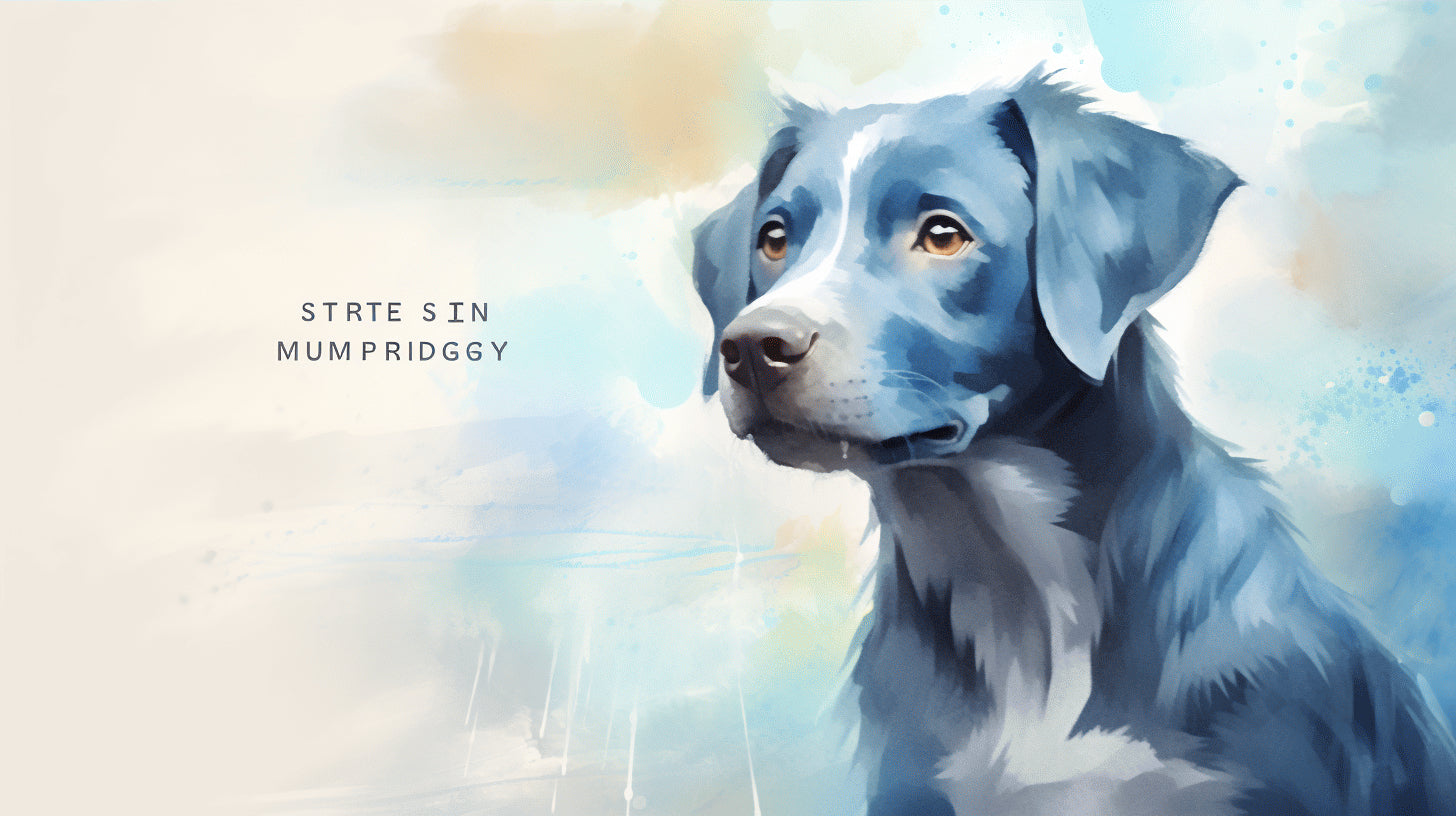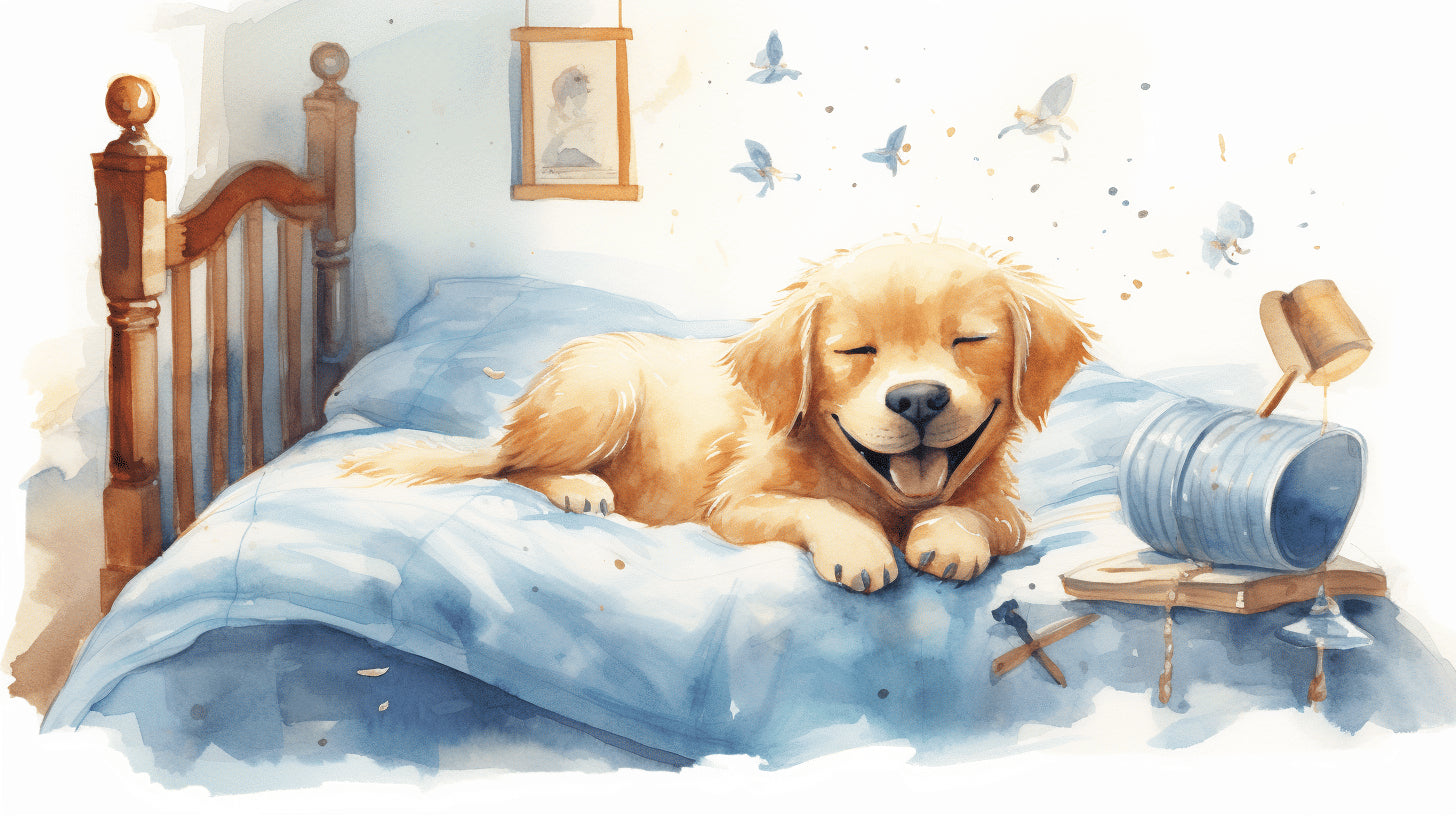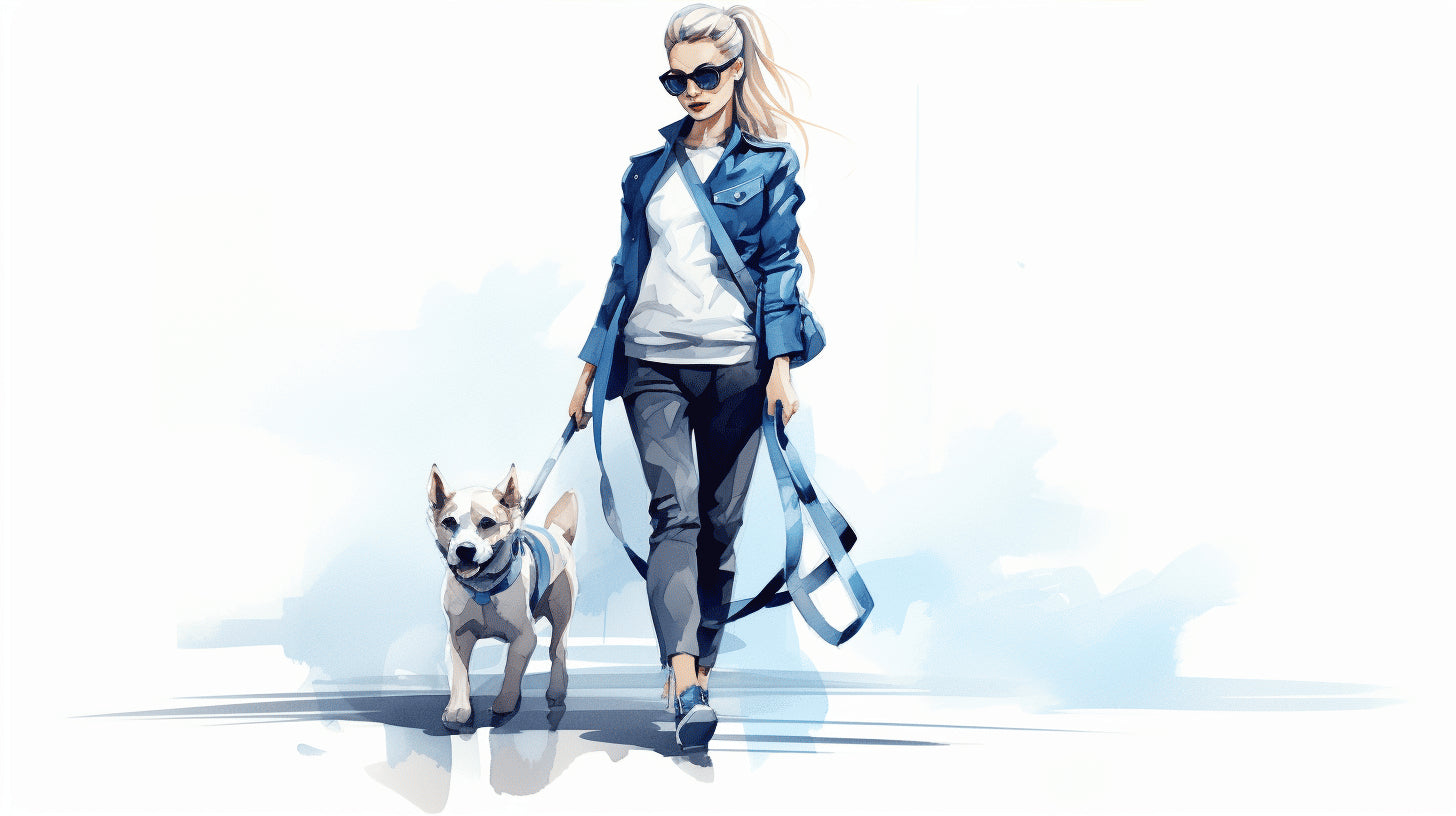As dog lovers, we cherish the irreplaceable bond we share with our furry friends. Their love and loyalty shine like a beacon, lighting up even the darkest of days. But just like their human companions, dogs too can grapple with emotional hurdles. Underneath their wagging tails and wet nose kisses could be a pup wrestling with anxiety.
Dog anxiety is a prevalent issue, shaping the behavior of our furry friends and sometimes making them overly defensive, scared, or even aggressive. However, all hope isn't lost! There are various methods, including comprehensive training programs, that can help your beloved pet bravely conquer the beast of anxiety. This article will journey through the ins and outs of dog anxiety, offering practical advice on its identification, understanding, effective treatment methods, and the remarkable role training plays in managing it.
Together, we shall strive to transform fearful pups into confident dogs, one wagging tail at a time! Because when it comes to our furry companions, happiness is truly a two-way street.
Identifying Dog Anxiety
Whether it's a wagging tail, a loving lick or a comforting cuddle, our four-legged friends display an unwavering affection that often brightens the dreariest days. But beneath their effervescent joy, millions of dogs battle a less observable adversary - anxiety. Understanding how to identify dog anxiety is a crucial step for dog-parents, ensuring their companions lead a jubilant and stress-free life.
Prevalence of Anxiety Among Dogs
Similar to humans, dogs experience a variety of emotions and, unfortunately, anxiety is one of them. The stressors responsible for dog anxiety can range from environmental changes, separation, or loud noises like firecrackers. However, it remains a relatively underexplored area, and many pet owners aren't aware of its prevalence.
Anxiety among dogs is more common than you might realize. Experts estimate that approximately 40% of dogs exhibit some form of anxiety. This significant amount underscores the importance of early identification and appropriate intervention. When left untreated, prolonged periods of anxiety could lead to health concerns and behavioral issues in dogs.
Methods to Identify Separation Anxiety
Recognizing separation anxiety in dogs is not always straightforward. Various signs might signal your canine buddy is dealing with this condition; you just need to know what to look for.
Most times, your dog will:
- Display restless behavior the moment they realize you're about to leave, usually displaying signs of agitation and nervous pacing.
- A drastic shift in their behavior when you're not present, displaying increased nervousness or fear.
- Display destructive behavior when alone, damaging furniture, digging holes, or excessive barking.
- Over-excitement when you reunite. They might leap, whine, or engage in frenetic behavior.
Further, according to recent studies, around 82.5% of trainers use multiple methods to work towards identifying separation anxiety among dogs. Using these variety of approaches highlights how individualized this process could be, understanding that each dog is unique and responds differently to varied stress triggers.
A brighter the future of pet anxiety lies ahead as researchers pioneer new ways to ease their distress. However, until that time comes, understanding and identifying dog anxiety is our strongest defense, helping our loving pets lead happier, stress-free lives.
Uncovering dog anxiety might be a challenging task, but your pet's well-being is always worth the extra effort. Stay prepared, stay vigilant, and remember - you're not alone in this journey. With a bit of determination and lots of love, we can make this world a safer, happier space for our furry companions.
Understanding Separation Anxiety
Separation anxiety can severely impact the emotional wellbeing of your beloved pet, causing repeated stressful instances that could potentially take a toll on their health. Recognizing the signs is crucial and seeking professional advice can help deal with the issue timely and appropriately. But what exactly is separation anxiety and how does it affect our loyal canine companions? Buckle up, as we navigate through this significant topic.
Importance of Veterinarian for Diagnosis
When it comes to diagnosing separation anxiety, a significant role is played by a veterinarian. However, a surprising fact is that only 7.9% of trainers refer pet owners to a veterinarian for a formal diagnosis. This underscores the important knowledge gap and also reaffirms the critical role of the vet in such conditions.
How exactly does a vet step in, you may wonder? Vets run diagnostic tests to rule out medical issues that might trigger such behavior and then examine if it's an emotional or behavioral problem. They can then guide with behavior modification techniques and even suggest medication if required.
Remember, only a veterinarian has the expertise to make an accurate diagnosis and formulate a treatment plan that’s tailored to your pet's condition.
Impact of Separation Anxiety on Service Dog Training
Now, moving onto another realm of impact, separation anxiety can have profound effects on service dog training. The striking data reveals that as many as 50% of service dogs reportedly have an 80% success rate in training. This indicates the sheer magnitude of the challenge that separation anxiety may pose in this field.
Service dogs with separation anxiety may face momentous obstacles in their training. They may have difficulty focusing on tasks, display destructive behavior when left alone, or even get noticeably agitated. This not only interferes with their training progress but also affects the owner's dependency on them as helpful companions.
The struggle can indeed be real, but with proper diagnosis, the right support, and effective training methods, a pet suffering from separation anxiety can still lead a happy, healthy life. So, let's never cease to pay attention to our furry friends' behaviors and emotional state. They have a lot to tell if we are ready to listen.
There you have it - a quick deep dive into the world of separation anxiety in dogs. The complex issue may seem daunting, but remember that with the right knowledge and support, it is highly manageable.
Effective Methods for Treating Dog Anxiety
We all cherish those moments of joyous afternoon frolics or snuggling up with a lovable pup. But, when man's best friend is dealing with anxiety, these blissful moments can be substituted by the distress of witnessing your four-legged companion grappling with nervousness. Luckily, a range of effective strategies exist for treating dog anxiety. We'll explore those strategies in this article.
Anxiety Wrap
One such method is using an anxiety wrap like Thundershirt. It's much like swaddling an infant that's wrapped tightly in a blanket to feel secure. Similarly, the pressure exerted by the anxiety wrap provides a comforting effect on dogs dealing with anxiety. And guess what? It boasts a noteworthy success rate of 44%.
Prescription Medication
Alternatively, veterinary-prescribed medication can be a viable option. This route, while it requires a vet's direct input, is known to yield effective results, alleviating symptoms of anxiety in your beloved pet.
Behavior Modification
Employing behavior modification, particularly the 'I'm Alone' practice, garners an impressive 80% success rate. Designed to tackle separation anxiety, this method helps dogs gradually become comfortable being alone.
AI Dog Training Device
There's also the very promising AI Dog Training Device. As one of the latest breakthroughs in the field, it has shown an outstanding early success rate of 100%. This device intelligently interacts with your dog to help manage their anxiety.
Front-loading Technique
Next up is the front-loading technique. This method has shown a high success rate in separation anxiety training. It involves rewarding your dog before the anxiety trigger kicks in. This preemptive strategy successfully redirects your dog's focus to something positive.
Desensitization and Counter Conditioning
Lastly, a specialized approach called desensitization coupled with counter conditioning works wonders. This combination strategy gradually exposes your pet to their anxiety triggers while simultaneously training them to associate these triggers with positive outcomes. No wonder it enjoys an unmatched 100% success rate!
In summary, diverse methods await exploration to help your dog combat anxiety. Guided by your pet's specific needs and the advice of a trusted vet, you're sure to find an approach that eases your furry pal's anxiety, helping them return to their happy, tail-wagging selves. Remember, the objective is to create a safe and comforting environment for your pet, where anxiety ceases to exist. Let love guide you as you embark on this journey towards healing and happiness.
Priceless Role of Training in Managing Anxiety
As pet-lovers, we all want our fur babies to stay happy and healthy. However, just like humans, dogs too can develop anxiety for various reasons. The good news is, with a strategic approach and relevant training, we can help manage our canine companion's anxiety effectively. Let's dive deeper into five crucial types of training that could assist in managing your dog's anxiety.
Obedience Training
The first step towards managing your pup's anxiety is through obedience training. This training, which involves teaching your dog basic commands like 'Sit', 'Stay', and 'Come', is an integral part of managing their anxiety. It builds mutual trust and respect between you and your dog, strengthens your bond, and, most importantly, provides a sense of security to the dog. When your dog feels safe, they're less likely to be anxious.
Positive Training Techniques
If your dog's anxiety is starting to affect their daily life, it's time to consider positive reinforcement measures. Positive training methods, such as reward-based training or clicker training, help anxious dogs associate positive feelings with certain actions or environments that previously caused them anxiety. These positive experiences can gradually overwrite their existing fears and anxieties, making them feel more comfortable and relaxed.
Structured Training Sessions
Consistency in training is key to managing dog anxiety. Interestingly, dogs thrive on routine and predictability. When you schedule structured training sessions, they know what to expect, addressing their fear of the unknown. Training sessions that are predictable not only provide mental stimulation but also help build confidence in your anxious dog.
Target and Duration Training
Now let's take a closer look at target training and duration training - both are powerful tools to reduce anxiety. Target training teaches a dog to touch a specific object or place with a part of its body, like a paw. Duration training, on the other hand, teaches a dog to hold a position, like 'Sit' or 'Stay', for extended periods. Both types of training give your dog a job to do, and focusing their attention on these tasks helps keep anxiety at bay.
Confidence Building Training Techniques
Finally, confidence building techniques can be game-changers for managing dog anxiety. Techniques like agility training or canine freestyle increase your dog’s confidence exponentially as they master new skills. As your fur friend becomes more self-assured, they'll likely show fewer signs of anxiety.
In sum, helping your pooch manage their anxiety may require time and patience, but the result - a happy and calm dog - is nothing short of priceless. Remember, the journey you’re embarking on with this training is not just about resolving an issue. It's about building a stronger bond with your furry friend, and at the end of the day, isn't that what pet ownership is all about?
Supportive Measures for Anxiety Management
Anxiety, a condition not only common in humans, but often reflected in our pets too. For dog owners, it becomes of utmost importance to chalk out an effective strategy for anxiety management. This discussion will delve into three broad measures: Creating an enriched environment, understanding the need for expert consultation, and ensuring regular exercise and recreation for your pet. All these steps can make a remarkable difference in a dog's life while allowing the pet-parent to create an unbreakable bond of benevolence.
Importance of Enriched Environment
Enriching your pet's environment is akin to painting a vibrant canvas of exploration for them, one that stimulates their senses and fuels their intellectual curiosity. However, there's a fine difference between a crowded mess and a thoughtfully accessorized setting. There are various ways you can ensure enrichment:
- Choosing interactive food puzzles
- Setting up a pet-friendly ambiance with soft music
- Allowing enough space for activities
Among these, food puzzles are proven to be extremely beneficial. They not only keep your pet occupied but also provide mental stimulation, enjoying a dual benefit.
Significance of Veterinarian Consultation
While a pet-parent's love is unconditional, it may not be enough in tackling the beast called anxiety. It is where professional advice comes in. Consulting with a veterinarian can help guide you in understanding your pet's behavior better. They also suggest targeted interventions like behavioral therapy. Here are some reasons why you might consider a visit:
- If your dog's anxiety symptoms are severe or persistent.
- Your dog's behavior has changed suddenly.
- Your efforts don't seem to be having a positive effect.
Alongside regular visits, maintaining a video log to record erratic behavior can aid in treatment decisions. It provides concrete evidence and assists the vet in pinpointing the root cause of your pet's anxiety.
Role of Exercise and Recreation
The real charm of having a pet cannot be felt until you both indulge in some heartwarming activities together. Exercise is a ticket to this joy ride.
Studies have shown that just like humans, exercise is a great stress reliever for anxious dogs too. It releases endorphins - the happy hormones, boosting their mood and reducing stress levels. Playing fetch, taking walks, or encouraging them to maneuver over Benefits of Using LivelyMat could be your daily go-to.
To conclude, managing anxiety in your pet requires a multifaceted approach. You become their pillar of strength, their guide through the storm. Remember, patience is key. Changes won't happen overnight, but with persistence and love, your furry friend will begin to show improvements. Their wagging tail and excited barks will be worth the effort.
Importance of Bond and Trust on Overcoming Anxiety
Overcoming anxiety is a significant milestone in any individual's path towards mental well-being. One of the most effective ways of combating anxiety is by fostering trust and strong bonds. Through these established relationships, a supportive environment is created, becoming a safe haven where one can express their fears, be understood, and eventually learn to cope.
Positive Reinforcement Training using Rewards
Anxiety can seem like an everlasting shadow, but with positive reinforcement training, we can learn to control it and push it away. This method works on the principle of encouraging good behavior and rewards that reinforce the desired behavior, thus solidifying good habits. It could be as simple as rewarding oneself with a piece of chocolate after having successfully faced a challenging situation, or celebrating small wins that gradually add up to significant victory over anxiety. Reward-based positive reinforcement not only boosts morale but also strengthens the belief that dread can be conquered one step at a time.
Cruelty-free Behavior Training Methods
Looking beyond traditional methods, cruelty-free training techniques offer a humane way of dealing with anxiety. These methods are focused on reducing anxiety at the core rather than just numbing its effects. They're designed to be gentle, empathetic, and respectful towards individuals' mental states, celebrating each progress step regardless of its size. Such steps work wonders in cultivating a loving, compassionate environment, wherein the anxiety slowly fades away, allowing the person's bravery to shine through.
Training Programs that Reinforce Bond and Trust
Trust and bonding remain pivotal movers in the fight against anxiety, and numerous training programs aim to solidify these elements. In these programs, participants are shown how they can rely on their relationships - be it with family, friends, or therapists - to help tackle anxiety. The support these relationships offer is essential in reinforcing one's belief that they can beat anxiety and are not alone in their battle, thus reducing anxiety and laying the groundwork for a healthier, happier mindset.
When we think of overcoming anxiety, it's crucial to remember that there's no 'one-size-fits-all' solution. Employing a combination of methods - like rewarding good behavior, incorporating cruelty-free approaches, and reinforcing bonds and trust via supportive programs - can help individuals navigate the labyrinth of anxiety towards sunnier paths of emotional well-being and resilience. After all, conquering anxiety is not merely about surviving; it’s about thriving with a renewed sense of courage, compassion, and connection.
Conclusion
In wrapping up, transforming a pet from an anxious fur-baby to a confident and well-adjusted companion is a journey. It demands time, patience, and consistent efforts. Despite the challenges, the transition invariably enriches the bond between you and your beloved pet. With the helpful insights, tools, and strategies discussed in this article, that journey becomes, hopefully, a lot less daunting.
At Empowered by Ashley, we understand the angst that comes with witnessing your furry friend suffer from anxiety. We also know the quiet triumph of overcoming such hurdles and having a healthier, happier pet as a result. That's why we provide a line of dog anxiety solutions designed with love, care, and a deep understanding of pet needs.
Remember one crucial thing: every dog is unique. Some techniques may work much better than others. It's all about finding a customized approach that works best for your dog.
With consistency, your dog can overcome anxiety and embrace a more joyful, carefree life. Trust in the process. Celebrate each victory, no matter how small. Most importantly, remember: it's not just about training; it's about forming a bond that lasts a lifetime. Your pet's confidence starts with your belief in them. So, gear up and embark on this incredible journey of transformation with your furry best friend.
Frequently Asked Questions
-
What causes anxiety in dogs?
Anxiety in dogs can be caused by various factors, such as separation from their owners, loud noises, changes in their environment, traumatic experiences, lack of socialization, or underlying health issues.
-
How can I tell if my dog is anxious?
Some common signs of anxiety in dogs include excessive barking, destructive behavior, restlessness, panting, trembling, pacing, hiding, loss of appetite, or excessive licking/grooming.
-
Can dog anxiety be treated with training?
Yes, dog anxiety can often be effectively managed and reduced through training methods that focus on desensitization, counterconditioning, positive reinforcement, and creating a safe and predictable environment for the dog.
-
Should I seek professional help for my anxious dog?
If your dog's anxiety is severe or has a significant impact on their quality of life, it is recommended to seek professional help from a veterinarian or a certified dog trainer with experience in anxiety-related behaviors.
-
Are there any natural remedies or supplements to help with dog anxiety?
There are natural remedies and supplements available that can help reduce anxiety in dogs. These include products like calming treats, pheromone diffusers, herbal supplements (e.g., chamomile), and CBD oil. However, it's best to consult with a vet before trying any new supplements or remedies for your dog.




















Leave a comment
This site is protected by hCaptcha and the hCaptcha Privacy Policy and Terms of Service apply.